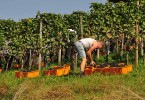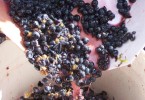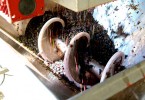Grappa: typical product of Veneto
Venetian Grappa is obtained by the distilled pomace and it is fully enclosed in the Atlas of the Agricultural traditional Products of Veneto and it is always the guest of honour on the tables of the foodies. Grappa is a traditional product thanks to its long history that tied it with its native territory but also for its huge success that delights for centuries the most polished palates.
The long history of the Venetian Grappa
History tells that Veneto give origin to this special spirit, distilled by the pomace of the typical Veneto wines. The pomace started to be distilled from the XIII and XIV century, using the residual pomace of the wine production, transforming it in a strong alcoholic drink. Grappa derives from the dialectal word “graspa”, from “graspo” the grapes’ stalk.
Venice, rich trading centre, used to sell lots of pomace and spirits produced in the territories of Serenissima (Republic of Venice) to the East and northern Europe with a healing and medical aim; doctors and pharmacists, in fact, used to produce the traditional Grappa with specific stills.
How to produce Venetian Grappa
The production of Graspa starts from the discarded pomace: the solid remains of grapes without stalks coming from the destemming process and the separation from the must.
Grape pomace ferments and then are placed inside a distiller placed over a flame; it is a more precise and technological tool than the old stills. The pomace inside the tank produces a steam that converged on a tube where the condensation occurs. The steam cools down and reaches the liquid state. A necessary step is the removal of head and the bottom of the distillation that is the beginning and the end of the process because they are rich in methanol and thus really dangerous if ingested.
Defining Venetian Grappa!
Which kind of spirits could answer to the title of Traditional Venetian Grappa? It is important, first of all, not to get wrong with the must spirits like aquavit or the wine spirits like brandy. The real Grappa derives exclusively from the pomace and its alcoholic volume shouldn’t be below 40° and can reach 60°.
Depending on the refining and the ageing times, Grappa can be:
- Young
- Aged (more than 12 months of ageing)
- Riserva or Stravecchia (more than 18 months of ageing)
Aromatic and flavoured
Grappa is aromatic if it comes from aromatic wines such as Traminer or Moscato wine or other sweet wines, typical of the North-East part of Italy.
Flavoured Grappa, instead, is a Grappa with flavoured additions: well appreciated is the fruity Grappa with wild berries, wild strawberries, blackberries, blueberries or raspberries. It can be flavoured with Cherries of Marostica IGP, with pears or elderberry. Grappa lovers enjoy the typical production of the Dolomites: juniper, cumin, rue or other aromatic herbs.
The best grapes to make Venetian Grappa
Venetian Grappa could be obtained by a single variety or a mix of grapes. Many Veneto DOC wines are perfect to prepare a good Grappa. Grappa can be obtained from Glera grapes, Prosecco wine variety, Amarone della Valpolicella grapes or Fior d’Arancio of the Euganean Hills.
Curiosities about Grappa
Grappa has its curiosities and characteristics, as many other spirits! For example, do you know the particular Treviso Red Chicory Grappa? And do you know that the typical recipe of the Venetian Chiacchiere (also called Galani) foresees the use of grappa instead of wine?








